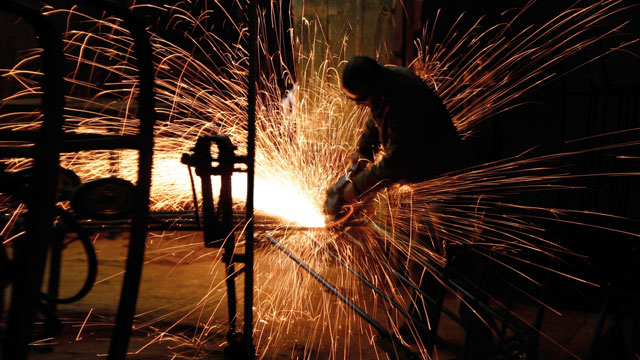
Workshops can be a particularly hazardous environment, with the number of tools, machines and chemicals in use. In this article Lucy Pritchard focuses on lighting, guarding, noise and ergonomic risks – as well as the emerging risks associated with Covid-19.
Lighting
Wherever possible natural light should be used for ambient lighting, but it is essential that glare and any difference in lighting levels in adjacent areas is minimised. The time it takes for your eyes to adjust could make the difference between a near miss and an accident.
Task-specific lighting must be bright enough to allow accurate perception of detail; this will also help to reduce the likelihood of visual fatigue. Equally, the type of lighting selected is key. For example, fluorescent tubes operating at mains frequency may be dangerous with rotating machinery since the rotating part can appear to have stopped. You may need to consider special fittings for flammable and explosive atmospheres, for example in spray booths, to reduce risks of ignition and explosion.
Keeping the noise down
Too much loud noise can cause deafness or permanent tinnitus. The impact of noise on individuals depends on both the volume of the noise and the length of time that someone is exposed to it.
If you cannot hear clearly what someone is saying (in a normal voice) when two metres away, the noise is likely to be at the first action level of 80dB(A) where hearing protection should be provided.
Options for controlling workshop noise levels include substituting quieter equipment, making sure machinery is maintained, enclosing the machine or process, and defining ear protection zones. Technical and organisational approaches should be used before resorting to hearing protection PPE.
Tools, equipment, machinery and dangerous substances
Fixed guards and interlocks can be used to isolate people from workshop hazards. These can include extended guards which are large enough to serve as noise enclosures when lined with noise absorbent materials.
Guards and local exhaust ventilation (LEV) can be used in combination to help enclose and control hazardous substances. LEV must be designed and installed by an expert so that you have the most appropriate system for your workplace. In most engineering workshops, thorough examinations are required every 14 months, or every six months where metal articles are abraded or polished for more than 12 hours a week. Records must be kept for at least five years. For more details on LEV, see page 32.
An ergonomic working environment
Most ill-health as a result of poor ergonomics arises from forceful or repetitive gripping, twisting, reach or other movements, without enough time for rest or recovery. It is important to address this since the pain, restriction of joint movement and soft tissue swelling that can result may lead to permanent disability.
Ergonomic risks can be reduced by, among other things, selection of tools offering the best protection, the use of balancers or tensioners to support tools or minimise vibration, and designing working arrangements to avoid awkward postures. This should be backed up by training.
Covid-19
One of the best ways of protecting each other from Covid-19 is to practice social distancing – maintaining a distance of 2m between each other. This could be achieved by marking out working areas, and restricting access to machinery which cannot be used. Shift working can be used to reduce the number of employees in the workshop at any one time. One-way systems can also help. You may consider enclosing certain processes with screens.
Where it’s not possible to maintain 2m distance, face coverings should be worn. These do not need to be of PPE grade unless required by the type of activity being undertaken.
Remember that workshops can be the source of some of the most life-changing injuries. Always take time to check everything is right before starting a job, and stay safe.
This is a broad introduction; best practice guidance on other issues in workshops can be found in HSG 129 from the Health and Safety Executive: www.hse.gov.uk/pUbns/priced/hsg129.pdf.
Lucy Pritchard is an elected member of IOSH Council and sits on the committee of the IOSH Construction Group

